Accepted Scientific Name: Euphorbia obesa Hook.f.
Bot. Mag. 129: t. 7888. 1903

Euphorbia obesa f. cristata Photo by: Valentino Vallicelli
This is a fascinating and rare plant with strong dark green fan-shaped crested branches forming a snaky ridge or crowded cluster.
Origin and Habitat: Garden origin.
Synonyms:
See all synonyms of Euphorbia obesa
back
Accepted name in llifle Database:Euphorbia obesa Hook.f.Bot. Mag. 129: t. 7888. 1903Synonymy: 3
Accepted name in llifle Database:Euphorbia obesa subs. symmetrica (A.C.White, R.A.Dyer & B.Sloane) G.D.RowleyEuphorbiaceae Study Group Bulletin 11(3): 97 (1998)Synonymy: 2
Cultivars
(2):
back
Common Names include:
ENGLISH: Crested Sea Urchin, Crested Baseball Plant
AFRIKAANS (Afrikaans): Vetmensie
Description: The well known standard form of Euphorbia obesaSN|1966]]SN|1966]] is a single-stemmed globular or shortly cylindrical plant that sometimes 'branch' or sucker, creating very odd looking clusters of spheres. It can grow to 20 cm in height with a diameter of 9 cm. The rare crested form is a very different fascinating plant.
Subspecies, varieties, forms and cultivars of plants belonging to the Euphorbia obesa group
Notes: The cause of cresting is not fully explained, biologists disagree as to why some plant grow in this unusual form. Some speculate that it is a genetic mutation. Others say it is the result of a lightning strike or freeze damage, but whatever the stimulus, the growth point of the stem has switched from a geometric point, to a line, which folds and undulates as the crest expands. Crested Euphorbia are quite rare, cresting occurs naturally and can be encountered in many other species.
 Euphorbia obesa f. cristata Photo by: Valentino Vallicelli
Euphorbia obesa f. cristata Photo by: Valentino Vallicelli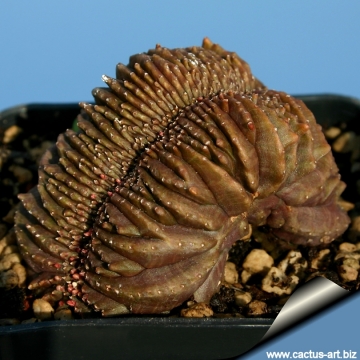 Euphorbia obesa f. cristata Photo by: Cactus Art
Euphorbia obesa f. cristata Photo by: Cactus Art Euphorbia obesa f. cristata Photo by: Gennaro Re
Euphorbia obesa f. cristata Photo by: Gennaro Re Euphorbia obesa f. cristata Photo by: Valentino Vallicelli
Euphorbia obesa f. cristata Photo by: Valentino Vallicelli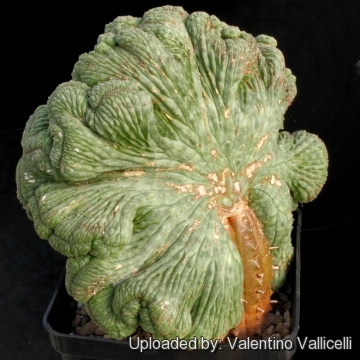 Euphorbia obesa f. cristata Photo by: Valentino Vallicelli
Euphorbia obesa f. cristata Photo by: Valentino Vallicelli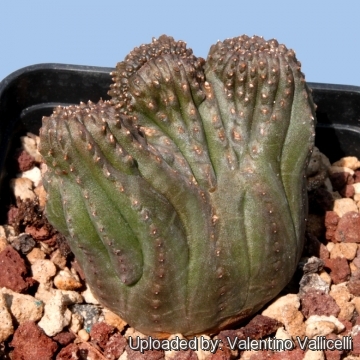 Euphorbia obesa f. cristata Photo by: Valentino Vallicelli
Euphorbia obesa f. cristata Photo by: Valentino Vallicelli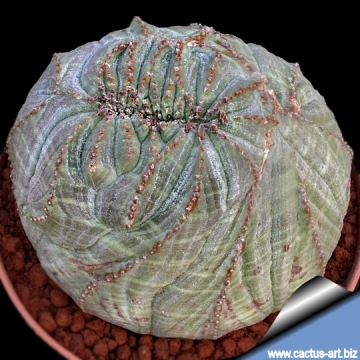 Euphorbia obesa f. cristata Photo by: Cactus Art
Euphorbia obesa f. cristata Photo by: Cactus Art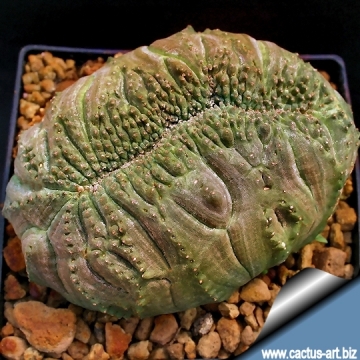 Euphorbia obesa f. cristata Photo by: Cactus Art
Euphorbia obesa f. cristata Photo by: Cactus ArtCultivation and Propagation: It is not too difficult in a greenhouse, although grows quite slowly. It is usually seen as a grafted plant but can grow on its own roots too.
Soil: Use a mineral well permeable soil with little organic matter (peat, humus).
Exposure: They need a good amount of light shade to full sun this help to keep the plants healthy, although slow growth.
Watering: Water sparingly from March till October (weekly during summertime, if the weather is sunny enough), with a little fertilizer added. Less or no water during cold winter months, or when night temperatures remain below 10° to prevent root loss. It is sensitive to overwatering (rot prone).
Fertilization: Feeding may not be necessary at all if the compost is fresh then, feed in summer only if the plant hasn't been repotted recently. Do not feed the plants from September onwards as this can cause lush growth which can be fatal during the darker cold months.
Hardiness: Keep perfectly dry in winter at temperatures from 5 to 15 degrees centigrade. (but it is relatively cold resistant and hardy to -5° C, or possibly colder for short periods) In the rest period no high atmospheric humidity!! (Temperature Zone: USDA 9-11)
Crested growth: Unlike 'monstrose' varieties of plants, where the variation from normal growth is due to genetic mutation, crested growth can occur on normal plants. Sometimes it's due to variances in light intensity, or damage, but generally the causes are unknown. A crested plant may have some areas growing normally, and a cresting plant that looks like a brain, may revert to normal growth for no apparent reason. If you have any of the crested part left you need to remove the normal growth and leave the crested part behind this will need to be done regularly.
Propagation: Grafting or cuttings. Plants are usually grafted onto column-shaped cacti but proved to be able to produce their own roots if degrafted. Cuttings will take root in a minimum temperature of 20° C (but better in hot weather). Cuttings of healthy shoots can be taken in the spring and summer. Cut the stem with a sharp, sterile knife, leave the cutting in a warm, dry place for a week or weeks (depending on how thick the cutting is) until a callus forms over the wound. Once the callus forms, the cutting may be inserted in a container filled with firmed cactus potting mix topped with a surface layer of coarse grit. They should be placed in the coarse grit only; this prevents the cut end from becoming too wet and allows the roots to penetrate the rich compost underneath. The cuttings should root in 2 to 6 weeks. Large crested piece must be placed on the soil surface without burying the plant base down in the soil.
Your Photos
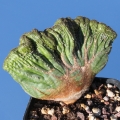
by Valentino Vallicelli

by Valentino Vallicelli
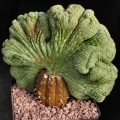
by Valentino Vallicelli
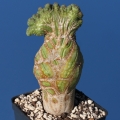
by Valentino Vallicelli

by Valentino Vallicelli
























